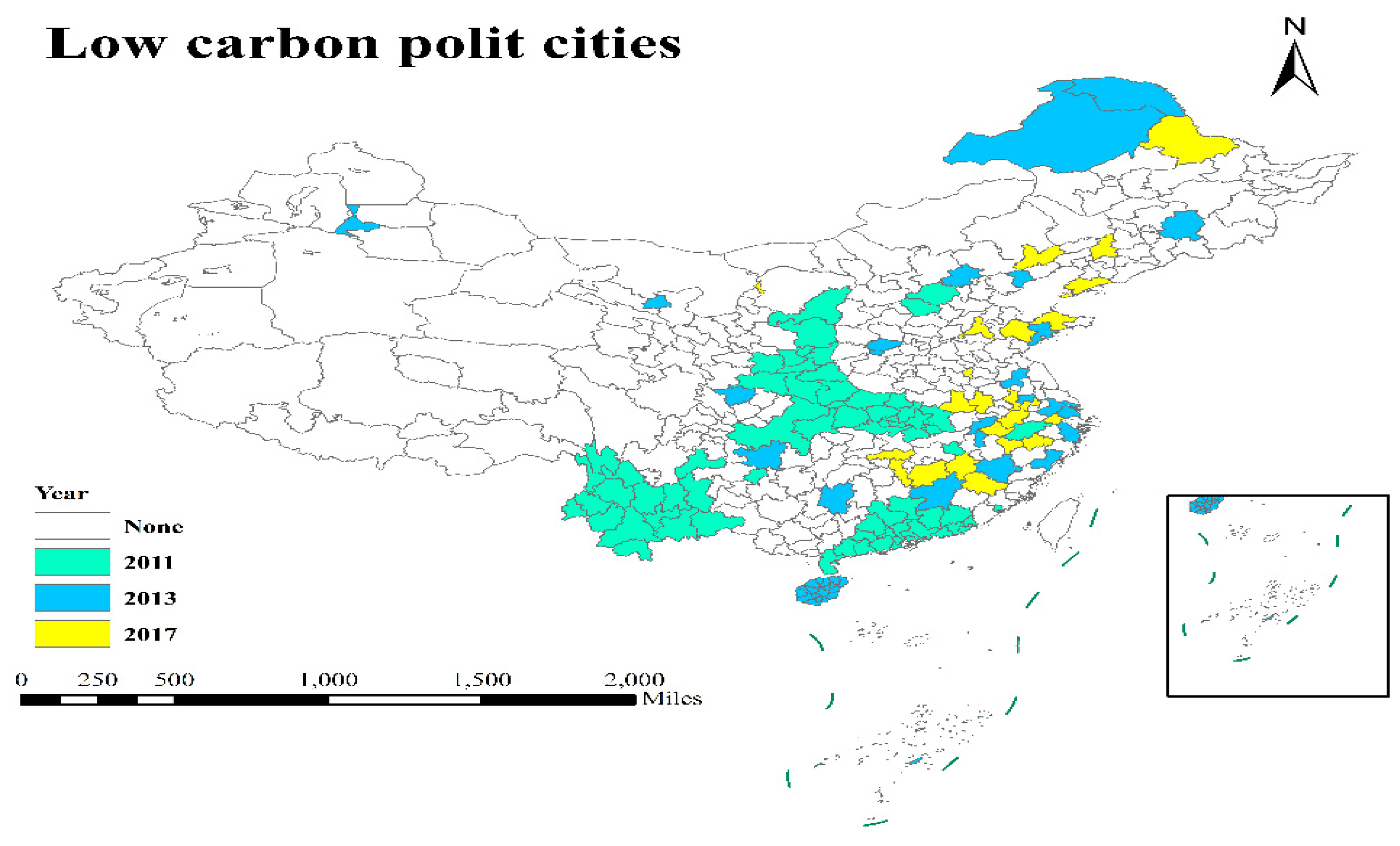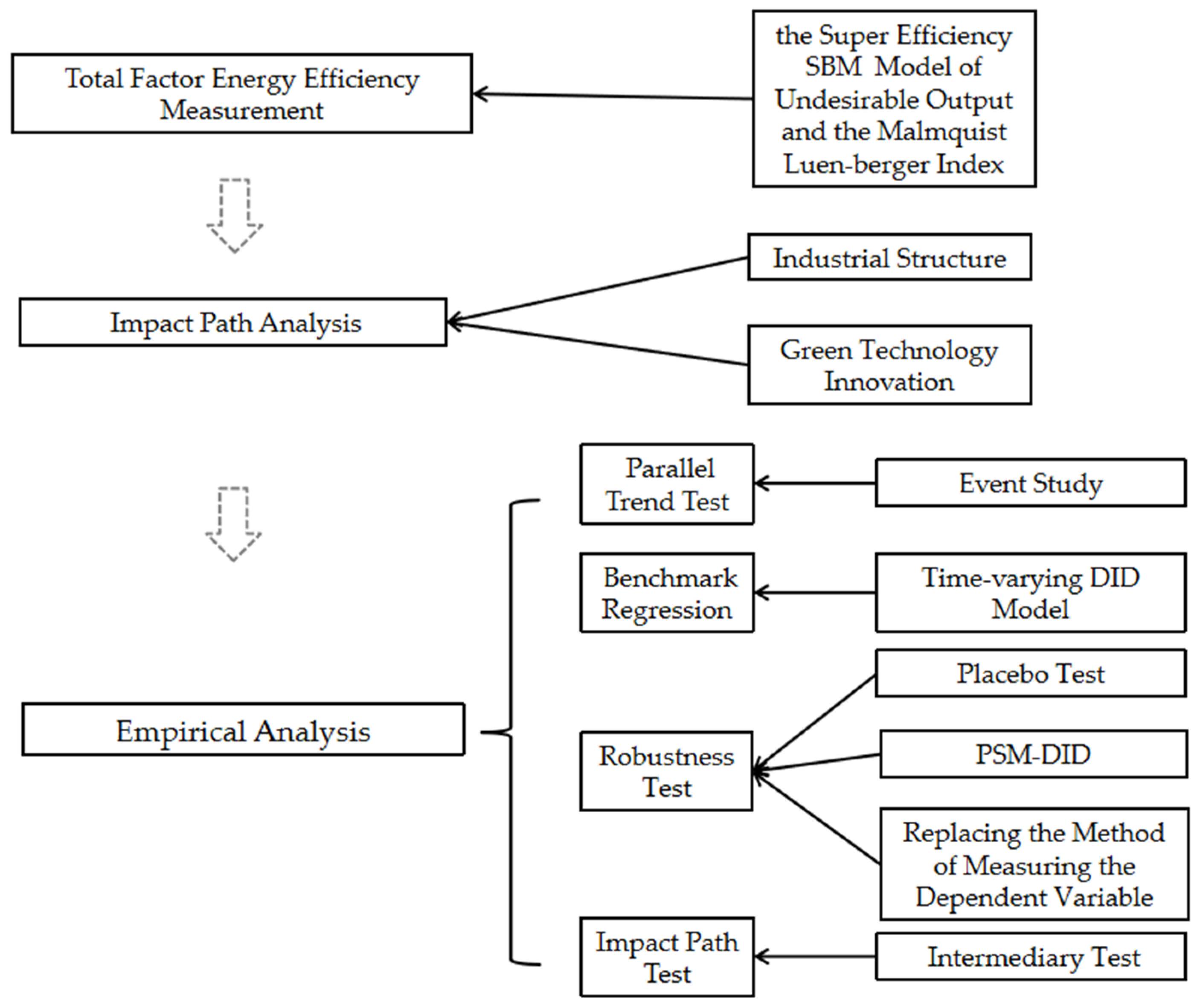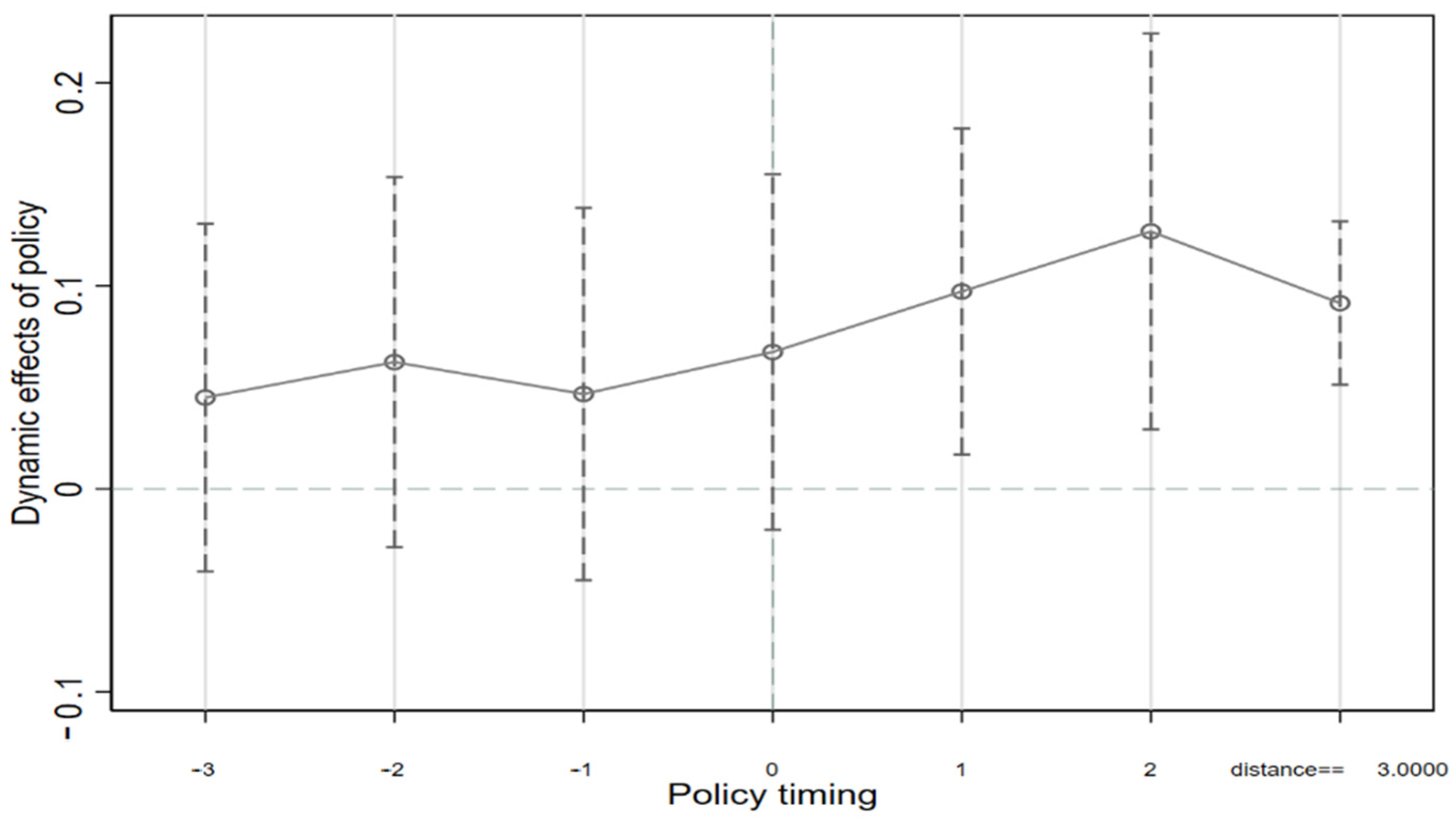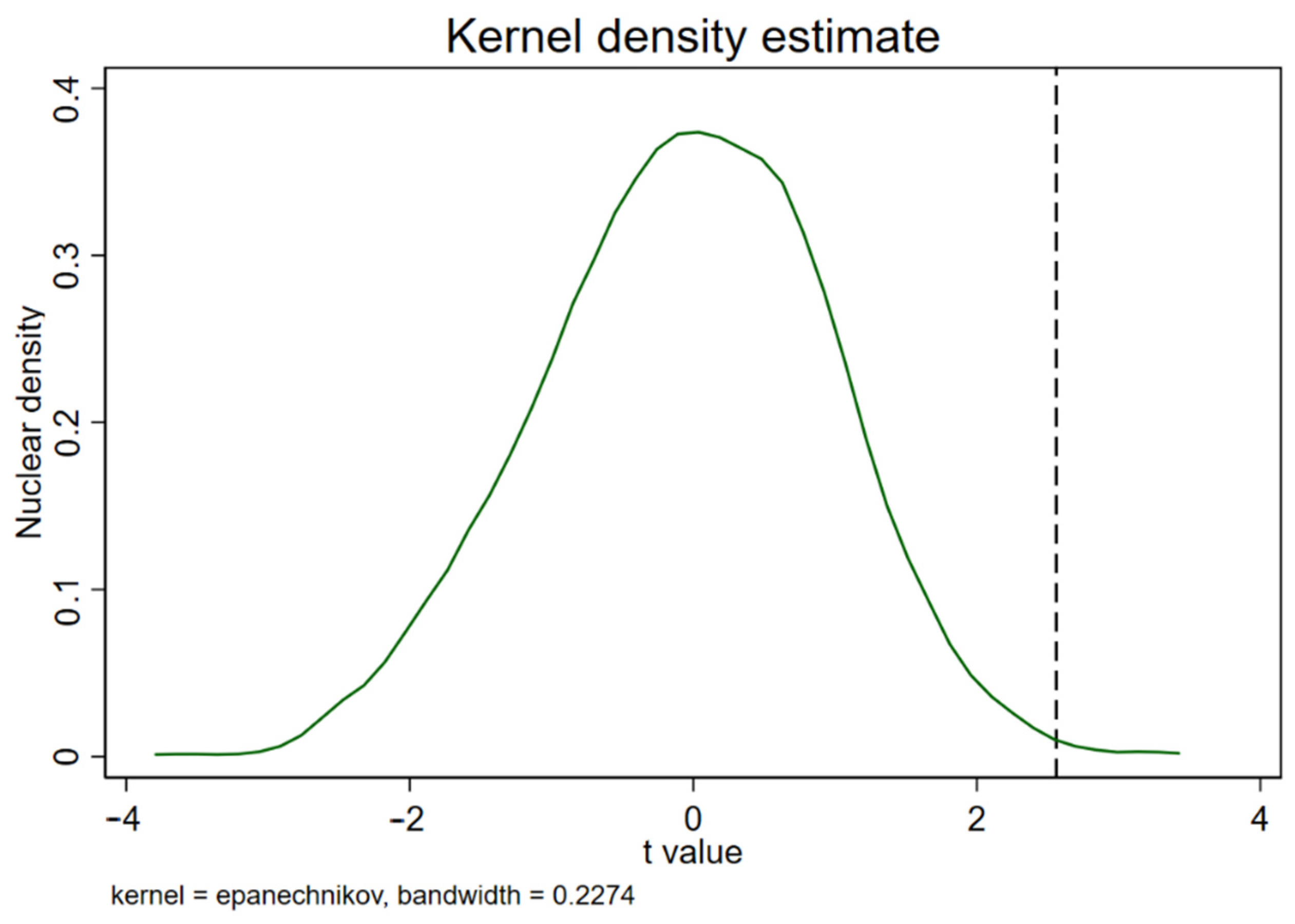3.2. Variable Selection
(1) Dependent variable—green total factor energy efficiency (GTFEE).
To measure energy efficiency, the SBM model of undesirable output exceeding efficiency and the Malmquist–Luenberger index are chosen to measure undesirable output (i.e., industrial smoke emissions, industrial sulfur dioxide emissions as well as wastewater emissions) of the process of consuming energy.
(i) Measurement method: total factor energy efficiency (TFEE) and single factor energy efficiency (SEE) are two examples of techniques useful for measuring energy efficiency. SEE is uncomplicated to measure and compare, but it only measures a single input factor of energy consumption without considering the impact of other input factors on economic output. This method of measurement has certain limitations. Hu and Wang introduced TFEE which calculates energy efficiency under the framework of TFEE [
15]. With the development of the economy, researchers further brought environmental elements into the total factor framework. The undesirable output super efficiency SBM-ML model can include undesirable output and dynamically analyze energy efficiency. The complicated situation can be resolved by using the super-efficient model. In this case, the efficiency of multiple decision-making units is one. This paper uses MAXDEA software to measure energy efficiency. The input–output index is set as below with reference to Wu et al. [
16] and Hao et al. [
17]. (a) Input: total energy consumption, labor input (towards the conclusion of the year, the real number of employees in each city), and capital input (calculated by perpetual inventory
, with the depreciation rate δ = 9.6%). (b) Expected output: constant price GDP (use the urban GDP deflator to reduce the 2007 urban GDP at constant prices). (c) Undesirable output: it includes the emissions of industrial wastewater, industrial smoke and sulfur dioxide.
The super efficiency SBM model is non-radial and proposed by Tone [
18]. In contrast to the conventional DEA model, the super efficiency SBM model contains relaxation variables, examining energy efficiency with output and input dimensions. It can also distinguish multiple effective DMUs. Undesirable output can be incorporated into the efficiency measurement process by using the SBM model with undesirable output. The energy efficiency will become more reasonable [
19]. Referencing the research of Sun et al. [
19], the undesirable output super efficiency SBM model is constructed as follows:
where
stands for the efficiency value,
stands for the input,
stands for the expected output,
stands for the undesirable output, and
is the weight vector. If
≥ 1, DMU is effective.
Chung et al. [
20] renamed the Malmquist index the Malmquist–Luenberger index It can dynamically analyze the effectiveness of each decision-making unit and contains the direction distance function of undesirable output. Refer to Färe et al.’s method, Malmquist–Luenberger index can be divided into efficiency change index and the technological change index [
21].
The ML index from t to t + 1 is shown in Equation (3).
(ii) Measurement data: Referring to the research of Li et al. [
22], the conversion coefficient of energy consumption is calculated by provincial level’s Liquefied Petroleum Gas (LPG), Natural Gas (NG), the Consumption of Electricity (CE) and Energy Consumption (EC). These data are available from the
China Energy Statistical Yearbook (2008–2020), issued by the National Bureau of Statistics. The municipal EC is calculated by municipal level’s LPG, NG, and CE, available from the
China Urban Statistical Yearbook (2008–2020), issued by the National Bureau of Statistics. The units of various EC are uniformly converted into 10,000 tons of standard coal.
First, we divide the LPG, NG and CE of each province by the total EC of the province to obtain the coefficient CEI. Second, we divide the LPG, NG and CE of each city by the coefficient CEI to calculate the total EC of the city. The formulas for these calculations are given in Equations (4) and (5).
where CEI represents the conversion coefficient of EC, t the year, PE
it province i’s CE at time t, PG
it the NG consumption of province i at time t, PL
it the LPG consumption of province i at time t and PEE
it the EC of province i at time t. The symbol CCE
it represents the EC of city i at time t, CE
it the CE of city i at time t, CG
it the NG consumption of city i at time t and CL
it the LPG consumption of city i at time t.
(2) Independent variable.
treatit × timeit: The product of the time grouping variable “time” and the experimental grouping variable “treat”. If city i is a LCPCP in year t, the assigned value is one. The other assigned values are zero. In this paper, three batches of LCPCPs had been respectively chosen in 2010, 2012 and 2017 as the experimental group, and other cities have been chosen as the control year.
(3) Control variables.
(a) Human capital (EDU): The enhancement of EDU is conducive to application, the R&D and promotion of energy-saving technologies, thereby improving energy efficiency [
23]. This study measures EDU by comparing the quantity of students enrolled in middle schools and universities to the entire populace at the conclusion of the school year.
(b) Government intervention (GOV): The market’s ability to allocate resources effectively is often distorted by excessive GOV in the economy. It may also result in resource waste and recurrent building; these are detrimental to the advancement of energy efficiency [
23]. Our study measures the level of GOV by the ratio of local fiscal budget expenditure to GDP.
(c) Foreign direct investment (FDI): FDI’s technology spillover effect, international competition effect, import and export commodity structure, energy price changes, international technology trade and other channels affect the efficiency of energy utilization. This paper measures FDI as a percentage of regional real GDP.
(d) Urbanization level (Citylevel): The improvement of Citylevel can slow down per capita residential energy consumption and promote production energy consumption. Urbanization’s effect on energy use varies depending on income levels as well. In low-income groups, urbanization reduced energy consumption; urbanization was not likely to have a significant impact on energy use for high-income groups [
24]. The percentage of urban residents in the population of a location is used in this study to gauge Citylevel.
(e) Economic development level (Rgdp): The advancement of energy efficiency is influenced by the degree of Rgdp. High levels of Rgdp are typically accompanied by greater financial policy support for the advancement of energy efficiency. Economic growth also reduced the energy consumption intensity of high-income and upper middle-income countries [
25]. In this study, per capita GDP is used to gauge the level of economic progress. For related discussions, refer to Wang and Wang [
26]. In order to deflate the urban GDP at the constant prices observed in 2006, the urban GDP deflator is utilized.
This research’s data come from the China Energy Statistical Yearbook (2008–2020), the China Urban Statistical Yearbook (2008–2020) and the China Statistical Yearbook (2008–2020). All these yearbooks are issued by the National Bureau of Statistics.











